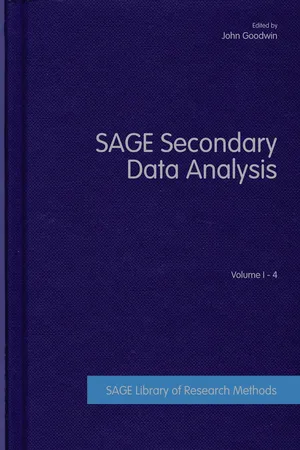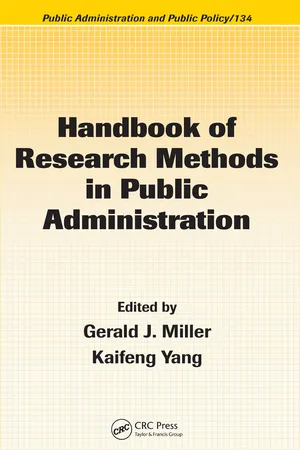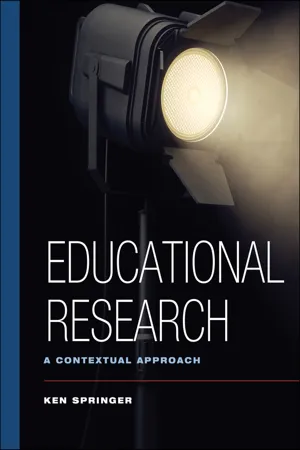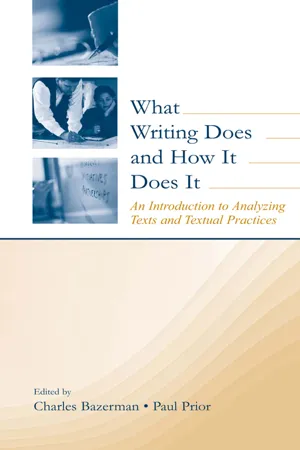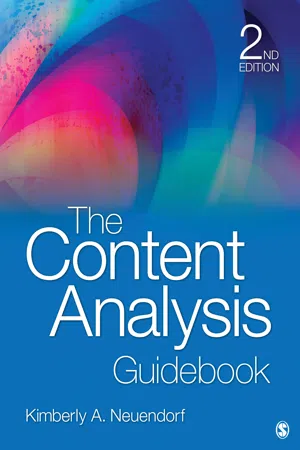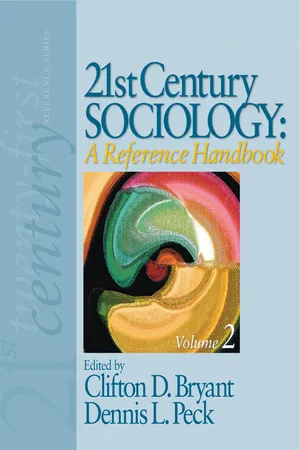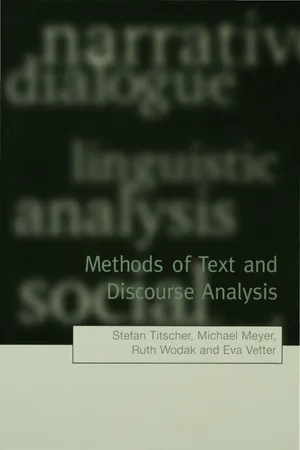Social Sciences
Content Analysis in Sociology
Content analysis in sociology involves systematically analyzing the content of various forms of communication, such as written, verbal, or visual materials, to identify patterns, themes, and meanings. Researchers use this method to study social phenomena, media representations, and cultural trends. By examining the underlying messages and symbols, content analysis provides insights into societal values, power dynamics, and social structures.
Written by Perlego with AI-assistance
Related key terms
1 of 5
12 Key excerpts on "Content Analysis in Sociology"
- eBook - PDF
- Roel Popping(Author)
- 2000(Publication Date)
- SAGE Publications Ltd(Publisher)
1 Text analysis: What and why? Text analysis encompasses a class of techniques for the social scientific study of communication. From one point of view text analysis, or content analysis, can be contrasted with observation. I Central to it is not the material, the visible, the audible, but the invisible: the world of meanings, values, norms as these are made accessible by symbolic behaviour (language, literature, plastic art, music). The 'content ' in content analysis is the material's meaning, i.e ., the social significance behind the visible or audible symbols in papers, books, film, recordings, pictures, paintings, or behind human activities in radio-and television broadcasts or in films. The focus is especially on the content of the message, by preference in mass communication where the message is addressed to many other people. Originally text analysis was used primarily to draw conclusions regarding the source of the message. Sources were often a collectivity, such as an organiza-tion, or a government. (See for example George [1959b].) However, communi-cation is more broadly understood as involving message, channel, audience, as well as source. In fact, these four aspects of communication represent the most common contextual variables used in analyses of texts and transcripts (Roberts, 1997b).2 Beyond examining symbolic content within various contexts, text analysis is used in bringing struc ture to an enormous amount of rather unstructured information. This allows the investigator to make explicit various aspects that might not be noticed by a lay observer. In this way a better understanding can be gained in certain aspects of societal processes. But the meaning of text analysis remains illusive. One might ask whether sensory perception can have the invisible and immaterial as its object. - eBook - PDF
- John Goodwin(Author)
- 2012(Publication Date)
- SAGE Publications Ltd(Publisher)
The article concludes with the relevance of the proposed methodological approach to tourism research – its strengths and limitations. Stepchenkova et al. Facilitating Content Analysis 419 Literature Review Content Analysis Content analysis is a nonobtrusive research methodology used to study a wide range of textual data – for example, various types of media messages, interview transcripts, discussion boards in virtual communities, and/or travel diaries. It is “a technique which aims at describing, with optimum objectiv-ity, precision, and generality, what is said on a given subject in a given place at a given time” (Lasswell, Lerner, and Pool 1952, p. 34). Berelson (1952, p. 18) summarized content analysis as a “research technique for the objective, systematic, and quantitative description of the manifest content of commu-nication.” More recently, Weber (1990, p. 9) described content analysis as “a research method that uses a set of procedures to make valid inferences from text.” Content analysis examines textual data for patterns and struc-tures, singles out the key features to which researchers want to pay attention, develops categories, and aggregates them into perceptible constructs in order to seize text meaning (Gray and Densten 1998; Shoemaker and Reese 1996). Content analysis is capable of capturing a richer sense of concepts within the data due to its qualitative basis and, at the same time, can be subjected to quantitative data-analysis techniques (Insch and Moore 1997). There are two general classes of epistemologies employed for content analysis in social sci-ences: qualitative and quantitative. The former term refers to nonstatistical and exploratory methods, which involve inductive reasoning (Berg 1995), while the latter term refers to methods that are capable of providing statistical inferences from text populations. - Sondra Brandler, Camille P. Roman, Gerald J. Miller, Kaifeng Yang, Gerald J. Miller, Kaifeng Yang(Authors)
- 2007(Publication Date)
- CRC Press(Publisher)
The technique is dynamic in the sense that the de fi nitions of content analysis have changed over time with technical innovations and application of the tool itself to new problems and types of materials. A couple of representative de fi nitions are as follows: ‘‘ Content analysis ’’ may be de fi ned as referring to any technique a) for the classi fi cation of the sign-vehicles, b) which relies solely upon the judgments (which theoretically may range from perceptual discriminations to sheer guesses) of an analyst or group of analysts as to which sign-vehicles fall into which categories, c) on the basis of explicitly formulated rules, d) provided that the analyst ’ s judgments are regarded as the reports of a scienti fi c observer. (Janis, 1949, p. 55) Content analysis is a phase of information-processing in which communication content is transformed, through objective and systematic application of categorization rules, into data that can be summarized and compared (Paisley, 1969). In the early stages of development, content analysis was considered to be a simple descriptive tool. Later, it was developed into an inferential tool through the creation of techniques that transformed the sign-vehicles into comparable data. In this chapter, content analysis is considered broadly as a scienti fi c data analysis technique which has the following characteristics: a. Systematic inclusion and exclusion of relevant sign-vehicles regardless of the researcher ’ s personal preferences or psychological tendencies. b. Each step in the research process is carried out on the basis of explicitly formulated rules. c. The fi ndings of the content analysis have theoretical or general relevance.* When an analysis of text exhibits these characteristics, it may be considered to be a content analysis.- eBook - PDF
Educational Research
A Contextual Approach
- Ken Springer(Author)
- 2015(Publication Date)
- Wiley(Publisher)
Through content analysis the researcher can describe materials, people, situations, and programs, and engage in inferences about associations and causal patterns. In short, content analysis is an indirect way of addressing virtually any topic that can be studied through other research designs. Content analysis is also the most suitable way of addressing certain research questions. For example, if we want to know how students with learning disabilities are portrayed in educational psychology textbooks, the best way to find out is to examine the books directly. Content analysis has been widely used among social scientists since the early 20th century. A content analysis may be carried out by means of quantitative, qualitative, or mixed-methods approaches. Analyses of student essays, for example, may include frequencies and means for different types of grammatical and spelling errors, as well as qualitative descriptions of recurrent themes. Some content analyses blur the quantitative–qualitative distinction—frequency data are reported, as in descriptive research, but the overall approach to analysis is qualitative. My focus in this chapter is on studies that rely exclusively or at least primarily on qualitative approaches to content analysis. Typically, a qualitative content analysis involves the restatement of a longer narrative (the original text) in terms of a shorter one (the content analysis) in which key themes are identified and analyzed. The Goals of Content Analysis Broadly, most content analyses reflect at least one of three goals (Krippendorf, 2003): • To reveal something about the materials • To reveal something about the creators of the materials • To reveal something about the context in which the materials were created Imagine that you are studying the portrayals of students with learning disabilities (LD) in several textbooks widely used in undergraduate teacher certification classes. - No longer available |Learn more
An Invitation to Social Research
How It's Done
- Emily Adler, Roger Clark(Authors)
- 2014(Publication Date)
- Cengage Learning EMEA(Publisher)
” SUMMARY Content analysis (as well as its offspring, visual analysis) is an unobtrusive, inexpensive, relatively easy, and flexible method of data collection that involves the systematic and — typically, but not necessarily — quantitative Summary 353 Copyright 2015 Cengage Learning. All Rights Reserved. May not be copied, scanned, or duplicated, in whole or in part. Due to electronic rights, some third party content may be suppressed from the eBook and/or eChapter(s). Editorial review has deemed that any suppressed content does not materially affect the overall learning experience. Cengage Learning reserves the right to remove additional content at any time if subsequent rights restrictions require it. study of one kind of available data — some form of communication. It, like other forms of available data analysis, provides a way to study the past. Con-tent analysis can be used to test hypotheses about communication, to com-pare the content of such communication with some standard, or to describe trends in communication, among other things. Clark, Kessler, and Coon simultaneously looked at trends in the visibility of female characters in chil-dren ’ s picture books and tested hypotheses about levels of female visibility in books by different groups of authors and illustrators. An early step in quantitative content analysis is to identify a unit of anal-ysis. This is the unit about which information is collected and can be words, phrases, or paragraphs; stories or chapters; themes; photographs; illustra-tions; authors; audiences; or almost anything associated with communication. In Clark, Kessler, and Coon ’ s study, the unit of analysis was sometimes whole books and sometimes illustrations. The quality of a content analysis depends on the creation and meaningful usage of variables for classifying units of analysis. - eBook - PDF
What Writing Does and How It Does It
An Introduction to Analyzing Texts and Textual Practices
- Charles Bazerman, Paul Prior, Charles Bazerman, Paul Prior(Authors)
- 2003(Publication Date)
- Routledge(Publisher)
MacNealy (1999) makes this point in re- gard to text analysis in general. Writing research is as much about the prod- ucts of writing as it is about the processes that produce and interpret them, and focusing on the text itself should be something that writing researchers welcome. Indeed, it can be argued that in recent years many writing re- searchers, in their zeal to study the sociocultural context in which writing takes place, have neglected the linguistic text itself. If so, content analysis, es- pecially of the hybrid type favored here, can be seen as a healthy corrective. Virtue 2: Content Analysis Can Be Done at a Time and Place Conven- ient to the Researcher. Unlike most other methodologies, such as ethnog- raphy, experimental research, or focus groups, content analysis does not require coordinating with other people or using special equipment other than, in most cases, a personal computer and modem. The one exception concerns testing for reliability, which involves using one or more col- leagues to serve as raters (see Step 4 under Methodological Procedure). Virtue 3: Content Analysis Yields Information No Less Valuable Than That Provided by Other Methods, and Does So With Greater Objectivity. Thomas (1994) argued persuasively that content analysis has been misrep- resented and unfairly maligned by its critics. She notes that although con- tent analysis does not provide direct access to an individual’s meaning- making processes, it is no different from any other technique in this regard. Rather, all research techniques involve the gathering of data that are then interpreted by the analyst. Making an important distinction between indi- vidual meaning making and cultural meaning making, Thomas argues that written artifacts “are important means by which [societal] customs and be- liefs are collectively expressed” (p. 686). - eBook - ePub
Qualitative Data Analysis
Practical Strategies
- Patricia Bazeley(Author)
- 2020(Publication Date)
- SAGE Publications(Publisher)
Content analysis of visual materials, in the form of counted frequencies with which selected visual elements or signs appear in a set of visual images, is a systematic method used for analysing trends over time or across different settings, primarily in studies of mass media (Bell, 2001). For example, to explore the dehumanisation of refugees in Australia, Bleiker, Campbell, Hutchison, and Nicholson (2013) reviewed 87 front-page pictures of asylum-seekers in two major newspapers over two critical time periods, looking only to see how many people were shown in each image, and whether or not you could discern the faces of those shown.Questions addressed by content analysis are clearly focused, sometimes stated as hypotheses. Sampling decisions are important, and what is to be coded is determined early in the process and then adhered to throughout. The sampling method and frame (inclusion/exclusion criteria) need to be clearly specified for both design and reporting purposes. Categories for coding need to be exhaustive, covering all content relevant to the research question, and, similarly, clearly defined and discrete (Bock, Isermann, & Knieper, 2011). As coding of visual data for content analysis remains an interactive (rather than automated) process (although potentially supported by QDAS or other data-management software), the reliability of coding is usually assessed. The meaning of pictures can be affected by the communication context in which they appear, and so information about that also needs to be noted. This includes both the physical context in which the items appear, and the social context, for example the protocols, or rules of behaviour, that govern the settings in which a set of photographs were taken (Bock et al., 2011).Content analysis is usually thought of as being more of a quantitative than qualitative method as the method generates counts which are usually analysed statistically. It typically neglects the meaning of the image – its ‘latent’ content (Banks, 2018). However, in qualitative and mixed methods studies a form of content analysis is often used as a first stage of a project to provide an overview of the available material, to then be followed up by a semiotic or discourse-style analysis (as in the Greenwood et al. study described in Example 11.2 - eBook - ePub
Introducing Research Methodology
Thinking Your Way Through Your Research Project
- Uwe Flick(Author)
- 2020(Publication Date)
- SAGE Publications(Publisher)
In the second part of the chapter, we will have a look at some qualitative approaches to analyzing data, including qualitative content analysis. Quantitative Content Analysis Content analysis is a classical procedure for analyzing textual material of whatever origin, from media products to interview data. It is ‘an empirical method for systematic, inter-subjectively transparent description of substantial and formal features of messages’ (Früh 1991, p. 25). The method is based on using categories derived from theoretical models. One normally applies such categories to texts, rather than develop them from the material itself – though one may of course revise the categories in the light of the texts under analysis. Content analysis aims at classifying the content of texts by allocating statements, sentences or words to a system of categories. This approach distinguishes between quantitative and qualitative content analyses, which we will address later. Analyzing newspaper articles While qualitative content analysis is seen as a method of analyzing data from interviews (see below), for example, some sources see quantitative content analysis rather as a specific method for collecting data (e.g. Bortz and Döring 2006; Bryman 2016). Schnell et al. (2008, p. 407) see the method as ‘a mixture of “analytic technique” and data collection procedure’. It is used for collecting and classifying information, such as in newspaper articles. Bortz and Döring provide the following as a definition: ‘Quantitative content analysis captures particular features of text by categorizing parts of the text into categories, which are operationalizations of the interesting features. The frequencies of the single categories inform features of the analyzed text’ (2006, p - eBook - ePub
- Kimberly A. Neuendorf(Author)
- 2016(Publication Date)
- SAGE Publications, Inc(Publisher)
summarized the state of news reporting across the sample of 297 stories.5. Content Analysis as Applicable to All Contexts
The term content analysis is not reserved for studies of mass media or for any other type of message content or context. As long as other pertinent characteristics apply (e.g., quantitative, summarizing), the study of any type of message pool may be deemed a content analysis. The messages may be mediated—that is, having some message reproduction or transmittal device interposed between source and receiver. Or they may be nonmediated—that is, experienced face to face. Although not attempting to create an exhaustive typology of communication purposes and context, the sections to follow give some examples of the range of applications of the techniques of content analysis.Individual Messaging
Some analyses examine the creation of messages by a single individual, with the typical goal of making some inference to that source (Chapter 2 will provide further discussion regarding limits to the ability to make inferences from content analysis findings).In psychology, there is a growing use of content analysis of naturally produced text and speech as a type of psychometric instrument (Gottschalk, 1995; Gottschalk & Bechtel, 2008; Horowitz, 1998; Tully, 1998). This technique analyzes statements made by an individual to diagnose psychological disorders and tendencies, to measure psychological traits of the source, or to assess the credibility of the source (Doris, 1994). Nearly all these efforts stem from the work of Philip Stone (Stone et al., 1966) in the Harvard Department of Social Relations. His “General Inquirer” computer program was the first to apply content-analytic techniques to free-speech words (see “Milestones in Content Analysis History” at The Content Analysis Guidebook Online, CAGO - eBook - ePub
Social Research Methods by Example
Applications in the Modern World
- Yasemin Besen-Cassino, Dan Cassino(Authors)
- 2017(Publication Date)
- Routledge(Publisher)
In terms of ethical considerations, content analysis is one of the easiest research methods to deal with. Because principal investigators are not dealing with human subjects, but rather using recorded material, they are not required to apply to their IRBs for approval before starting their research projects. Because content analysis uses secondary data, which already exists in recorded material, it does not use human subjects. Therefore, with content analysis, there is no potential harm to human subjects. In recent years, however, researchers have started to debate the potential harm in content analysis. Content analysis does not directly deal with human subjects, but it might indirectly cause potential harm by violating their privacy. Think about the study of Christie’s novels. Based on the content analysis of her novels, the researchers concluded that Christie might have had Alzheimer’s disease. Given that the author is deceased, what are the ethical obligations of the researcher? It is certainly possible to uncover something during content analysis that the author might be trying to keep private. Therefore, even though we do not typically think of content analysis as potentially harming human subjects, it is important to keep in mind that individuals potentially can be harmed. Researchers still need to be cautious of issues of privacy.ADVANTAGES AND DISADVANTAGES OF CONTENT ANALYSIS
Content analysis has many advantages. Unlike many other techniques we studied in this book, content analysis is the only technique that does not directly deal with people. In-depth interviews, surveys, and experiments all focus on the individual participant or respondent: asking questions; recording the participant’s reactions, behavior, attitudes, or values. Content analysis, however, systematically studies patterns in printed or visual media. There are some research questions that can only be answered with this method. Do cartoons use aggressive messages? Do advertisements use more white models than African American models? Do presidential speeches use religious messages? These are not questions researchers can answer by directly asking individual people. If researchers want to capture the nonliving portion of culture, content analysis provides them with the tools to systematically analyze it.Content analysis is especially useful in women and gender studies. Many feminist scholars argue that historical reports are biased because they come from the perspective of men. Using historic artifacts, diaries, letters, and women’s narratives, many feminist scholars conduct content analysis to capture the perspectives of women. Women’s perspectives have historically been marginalized; content analysis sheds light on these untold stories.Content analysis is also an unobtrusive measure - eBook - ePub
- Clifton D. Bryant, Dennis L. Peck, Clifton D. Bryant, Dennis L. Peck(Authors)
- 2006(Publication Date)
- SAGE Publications, Inc(Publisher)
The rise of television and its perceived power created a new wave of interest in content analysis particularly in the study of problem areas such as violence, advertising, and pornography. One of the primary centers for this work, especially for the study of televised violence, was the Annenberg School of Communication, which used the support of the Annenberg Foundation and government funding to carry out content analyses of televised violence as well as of commercial advertising (Gerbner and Gross 1980). This research was widely followed by activists and policymakers who used the results on what they perceived to be extensive televised violence, commercialism, and explicit depictions of sexuality to promote regulation and to pressure broadcasters. The research and its influence gave new life to content analysis, and it has remained a leading approach to examining media content. But content analysis has also come under criticism, not only because it neglected the role of opinion leaders and other important social actors but because it neglected to account for the interpretive powers of audiences.Discourse analysis provided the major alternative in the study of content. This approach drew heavily from cultural studies that extended its influence across the social sciences and humanities in the 1970s. Cultural studies is a broad-based intellectual movement that concentrates on the constitution of meaning in texts, defined broadly to include all forms of social communication. It has grown from many strands, including one based on the drive to oppose academic orthodoxies, particularly the tendency to organize knowledge in disciplinary canons such as English literature. The approach now contains numerous currents and fissures that provide considerable ferment from within as well as without. From the beginning, especially in the British context, cultural studies have been strongly influenced by Marxian perspectives, including the tendency to see culture as intimately connected to social relations, particularly as organized around class, gender, and race, with a focus on their asymmetries and antagonisms. Furthermore, Marxian concerns with power, particularly the power to define and realize needs and interests, influenced the development of cultural studies, as is evidenced, for example, in the work of Thompson (1963) and Willis (1977), which brought to the fore the cultural construction of class relations. Marxian concerns are also exemplified in the work at the Centre for Contemporary Cultural Studies in Birmingham, prominent in the research of Hall (1982). This concentrated on the view that culture is neither independent nor externally determined but rather is best viewed as the site of social difference, struggle, and contestation. Indeed, commentators have noted that one of the significant differences between the British and American approaches to cultural studies is that the former has adopted a more explicitly Marxian and generally political position. Cultural studies in the United States also contain numerous divisions, but one can safely conclude that there is a greater tendency for them to draw inspiration from a pluralist conception of society and politics that sees power as widely dispersed, from functionalist anthropology and sociology, which concentrate on how cultural practices maintain order and harmony in social life, and from symbolic interactionist social psychology, which uses the language of ritual and drama to examine the production and reproduction of symbolic communities (Carey 1979). - eBook - ePub
Methods of Text and Discourse Analysis
In Search of Meaning
- Stefan Titscher, Michael Meyer, Ruth Wodak, Eva Vetter(Authors)
- 2000(Publication Date)
- SAGE Publications Ltd(Publisher)
Handbook of Social Psychology (Lindzey & Aronson 1985) there is no entry for content analysis. In place of this the authors have included a more general account by Clark (1985), ‘Language Use and Language Users’, which also outlines linguistic theories and methods (such as speech act analysis, conversation analysis). It can even be seen from the heyday of secondary publications on content analysis – the 1970s and early 1980s – that the lifecycle of the method has passed its peak and that a phase of differentiation has now begun.Herkner, Werner (1974), ‘Inhaltsanalyse’, in Jürgen von Koolwijk & Maria Wieken-Mayser (eds), Techniken der empirischen Sozialforschung, vol. 3, München: Oldenbourg, 158–91.Herkner’s contribution to this manual gives a comprehensive overview of the emphases, the theoretical foundations and the procedures employed in content analysis research.Holsti, Ole R. (1968), ‘Content Analysis’, in Gardner Lindzey & Elliot Aronson (eds), The Handbook of Social Psychology, (2nd edn), vol. 2, Research Methods, Reading: Addison-Wesley, 596–692.Holsti provides, almost as a summary of his methodological book (1969), an overview of essential questions and procedures used in content analysis.Mayring, Philip (1991), ‘Qualitative Inhaltsanalyse’, in Uwe Flick, Ernst von Kardorff, Heiner Keupp, Lutz von Rosenstiel and Stefan Wolff (eds), Handbuch Qualitative Sozialforschung, München: Psychologie-Verlags-Union, 209–13.Philip Mayring’s contribution, which briefly outlines his ‘qualitative content analysis’, is included in this German manual of qualitative social research.Silbermann, Alphons (1974), ‘Systematische Inhaltsanalyse’, in René König (ed.), Handbuch der empirischen Sozialforschung, vol. 4, Komplexe Forschungsansatze, Stuttgart: Enke, 253–339.Alphons Silbermann’s contribution is particularly impressive for its thorough presentation of the historical development of the method. As fields of application, Silbermann describes the analysis of cultural and social thought systems, literary analysis, the analysis of stereotypes and symbolic representations, and the use of content analysis in warfare and politics. An overview of content analysis research in mass communication is followed by a section on the further development of the method and a short account of techniques.
Index pages curate the most relevant extracts from our library of academic textbooks. They’ve been created using an in-house natural language model (NLM), each adding context and meaning to key research topics.

